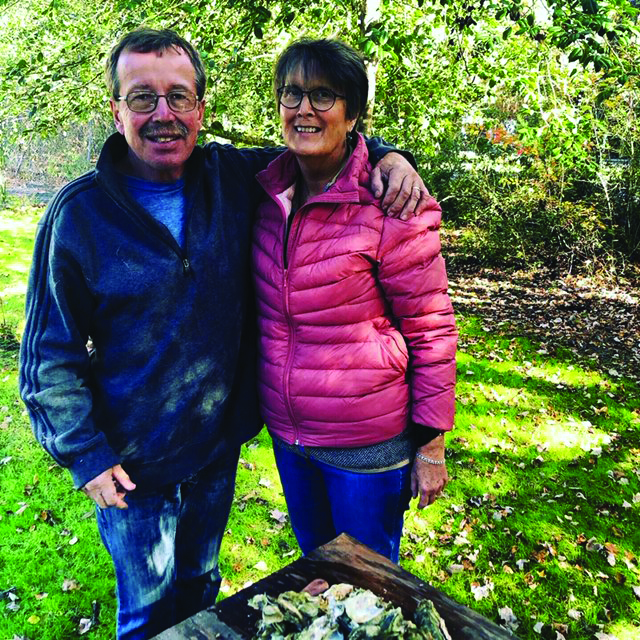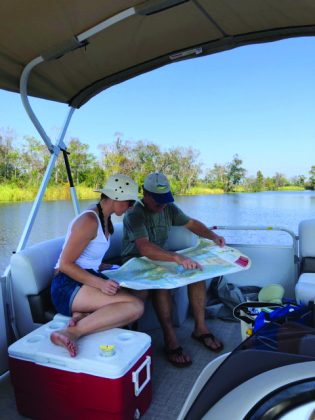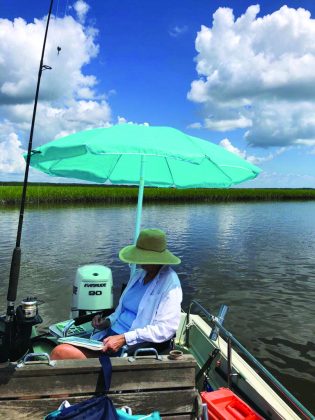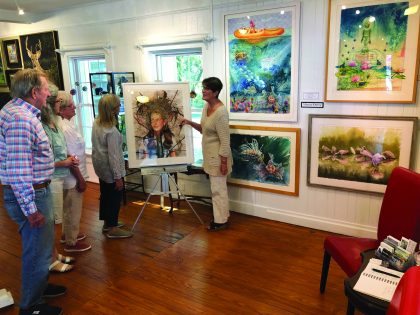
Subscribe to our newsletter
Enter your email address below and subscribe to our newsletter

While we chatted in their home tucked away on a quiet street in Pawleys Island, Maura and Paul Kenny told me repeatedly how fortunate they feel to have such satisfying lives. Both are recently retired from prestigious careers, and because they loved their work, Maura and Paul have combined their knowledge and experience into a new body of work that suits their laid back lifestyle.
Maura began talking first, telling me about her years as an art professor at Coastal Carolina University. “I started working for CCU when it was still a part of University of South Carolina in the mid-1980s,” she began. “In the 34 years I worked there, we went from a small art department of four or five faculty members to a department of 20 when I retired in 2018.” This dedicated educator went on to tell me that many of her students have gone on to do wonderful things in all areas of the arts.
The day we met, Paul and Maura were waiting on the birth of their first grandchild, a girl, Murphy Rose Kenny. A huge pink package sat on the hearth of a stone fireplace, waiting to be taken to their son Billy’s home in Charleston where he lives with his wife, Aly Murphy. The couple also has a daughter, Emily, who lives in Rock Hill, South Carolina, with her husband Jackson Emerson.
Even after living in the States since 1980, there is still a hint of a pleasant Irish accent in Paul’s voice. He first told me the story of how he and Maura met. “We met in a pub in Ireland in 1976.” Maura interjected, telling me with a laugh that the pub’s name was Durty Nellie’s. Maura had taken a job teaching art in an elementary school in Connecticut right after college, and she and a friend decided to take a trip to Ireland during their summer break. Continuing, she said, “Paul talked me into coming to the bank where he worked the next day, saying he’d give me a better exchange on my dollars.”
The couple laughed remembering, and Paul continued this romantic story. “I knew if I didn’t say something, she would leave and I’d never see her again. This was before cell phones and email, so I had to think of something fast.” Maura did go to that bank the next day and a lifelong love was born. The couple married in 1981.
By 1980, Paul knew that he wasn’t suited for a banking career, and after meeting Maura living in the States seemed even more attractive. So when he had the opportunity to attend Coastal Carolina University, he never looked back. “I sold my car and my few possessions, and came to the states with about $3,000.” Luckily, tuition at Coastal wasn’t very expensive in the ‘80s, and combined with a few scholarships he was able to make ends meet. He found Marine Science was a perfect fit having grown up on the coast of Ireland. He was a regular member of the Irish Surf Team and always had a fascination for life in the ocean. Opportunities in Marine Science were limited back then, so Coastal Carolina was the perfect place for Paul. “While studying at Coastal, Dr. Richard Dame hired me to work on a primary productivity grant at USC’s Baruch Maine Lab during the summers.” “After I graduated in early 1983, Dr. Dame asked me if I would delay moving on in my career and work for him for a year. He had lost a technician and I already understood the job.” Paul agreed and that one year transitioned into a 35 year career of scientific discovery.
After working for four years as an elementary school art teacher, Maura decided to go back to school to focus on her art and develop herself as an artist. She received her MFA from UNC-Greensboro about the same time Paul decided to attend Coastal. “When he told me he was moving to Conway to attend Coastal, I decided to go with him,” Maura shook her head, remembering how moving to a completely new place seemed easy at the time. “We knew nothing about the area and lived in a tent for a week before finding someplace to stay. I started to work part time at Coastal and fortunately, they eventually hired me full time.”
“My father raised seven children,” Maura said, as we talked about her life as an art educator. “When I told him I wanted to be an artist, he asked me to think about being an art teacher so I could always support myself. He didn’t want me to be a starving artist!” It was a good choice, and between her years as an elementary school art teacher and college art professor, Maura taught for 40 years, enjoying every minute. “I believe the youth of today is amazing – they are open and accepting and so creative. I’ve learned so much from them.”
“I began working on a project, funded by NSF, measuring primary production of Spartina, figuring out how much carbon the marsh grasses produce,” Paul told me, when I asked about his work. “It turns out that southeastern salt marshes are one of the most productive ecosystems in the world, rivaled only by tropical rain forests.” Next, Paul worked on a shellfish research project, spending the next five years studying the ecology of oysters and how they fit into the ecosystem of North Inlet. “Oysters are a keystone species, which means without them the entire ecosystem would fail.”
By 1989, Maura and Paul were both established in their careers and lived on the Hobcaw Barony property in the gatehouse by the highway. “When Hurricane Hugo came through that September it destroyed our lab,” Paul told me. “Five feet of water flooded the building and the tidal surge moved it off of its foundation.” Paul added that he and Maura, along with their six month old daughter, rode out the monster storm in a dorm building on site.
 By 1992, the Baruch Marine Lab was rebuilt and the North Inlet-Winyah National Estauarine Research Program (NERR) was established. Paul was then hired to work for the NERR. “I was the first technician with USC to run basic water quality programs,” Paul said. Because of his tenure at the Marine Lab, a few years later Paul was hired into a “hard” position, one not funded by grants. In this position, he worked for Dr. Dennis Allen on his plankton and fishery surveys, and oversaw the general use of the facility and helped researchers get started. This involved a change in many of his responsibilities, requiring him to get his boat captain’s license. “I was responsible for an education program taking college students out on a boat to show them, in the real world, what they learned in books at college. I did that for nearly 20 years.” Paul loved his work with the students. “It was a wonderful experience. Oftentimes, students would come from the upstate or from states around the country, and many of them had never been out on the water. To see them ooh and ahh over a dolphin sighting or learn something new about the ecology of the environment was very gratifying.” Even before he retired, Paul would take people interested in learning about our environment out in his personal boat. Now, in retirement, he runs boat tours, with his business, Low Country Eco Adventures, that educates his passengers on a variety of topics, including history and ecology.
By 1992, the Baruch Marine Lab was rebuilt and the North Inlet-Winyah National Estauarine Research Program (NERR) was established. Paul was then hired to work for the NERR. “I was the first technician with USC to run basic water quality programs,” Paul said. Because of his tenure at the Marine Lab, a few years later Paul was hired into a “hard” position, one not funded by grants. In this position, he worked for Dr. Dennis Allen on his plankton and fishery surveys, and oversaw the general use of the facility and helped researchers get started. This involved a change in many of his responsibilities, requiring him to get his boat captain’s license. “I was responsible for an education program taking college students out on a boat to show them, in the real world, what they learned in books at college. I did that for nearly 20 years.” Paul loved his work with the students. “It was a wonderful experience. Oftentimes, students would come from the upstate or from states around the country, and many of them had never been out on the water. To see them ooh and ahh over a dolphin sighting or learn something new about the ecology of the environment was very gratifying.” Even before he retired, Paul would take people interested in learning about our environment out in his personal boat. Now, in retirement, he runs boat tours, with his business, Low Country Eco Adventures, that educates his passengers on a variety of topics, including history and ecology.
 “One of my great joys is being on the river or out in Winyah Bay because the landscape is so beautiful,” Maura told me, as she began to talk about her current projects. “If I can make a painting that is moving enough to show what’s out there, I am very gratified. Many people don’t have access to the rivers or a boat and have no idea about the beauty of our waterways.” Maura also has an interest in historical sites and learned the fundamentals of oil painting from her mentor who owned a 17th century historical house museum in Connecticut. Through Maura’s art and Paul’s extensive scientific knowledge, the two have morphed their careers into something they both love.
“One of my great joys is being on the river or out in Winyah Bay because the landscape is so beautiful,” Maura told me, as she began to talk about her current projects. “If I can make a painting that is moving enough to show what’s out there, I am very gratified. Many people don’t have access to the rivers or a boat and have no idea about the beauty of our waterways.” Maura also has an interest in historical sites and learned the fundamentals of oil painting from her mentor who owned a 17th century historical house museum in Connecticut. Through Maura’s art and Paul’s extensive scientific knowledge, the two have morphed their careers into something they both love.
Since her retirement, Maura has worked exclusively as an artist, creating quite a large body of work, focusing on portraiture and the natural world. On September 24th, her work will be featured in a show titled, Where the Rivers Flow, at The Art Museum in Myrtle Beach. “The paintings feature vistas and structures and people from our travels on the Waccamaw River, the Pee Dee River, Winyah Bay and our time cruising and oystering in the salt marsh of North Inlet. It’s a miniscule part of what’s out there, and I hope it piques people’s interest in our rivers.” Maura has finished all of the paintings for her upcoming show and will spend the summer preparing. She also is in the middle of another series of paintings that combines figures with natural elements.
 Maura’s introduction to Laura Herriot, well known Sandy Island resident and owner of Wilma’s Cottage, the only bed and breakfast on the island, led to another exciting project for this prolific artist. “I first met Laura when our friends and colleagues, Lee Brockington and Linda Ketron, hosted an open house and fundraiser to help pay for much needed repairs to Wilma’s Cottage,” Maura said as she told me about her latest partnership. “Paul had been asked to ferry people back and forth, and I stayed at the house. Paintings of Laura and her granddaughter will be a part of my show.”
Maura’s introduction to Laura Herriot, well known Sandy Island resident and owner of Wilma’s Cottage, the only bed and breakfast on the island, led to another exciting project for this prolific artist. “I first met Laura when our friends and colleagues, Lee Brockington and Linda Ketron, hosted an open house and fundraiser to help pay for much needed repairs to Wilma’s Cottage,” Maura said as she told me about her latest partnership. “Paul had been asked to ferry people back and forth, and I stayed at the house. Paintings of Laura and her granddaughter will be a part of my show.”
“Linda is publishing a book about Sandy Island, Sandy Island: Now and Forever, and asked me if I would be interested in painting the cover,” Maura told me, obviously excited about this work. “I told her I had a series of river paintings and took 15-20 paintings for her to see.” Linda loved Maura’s work and has incorporated most of them into the book. “For one chapter, Linda needed a painting of the rice chimney on the old Laurel Hill Plantation, now a part of Brookgreen Gardens. So Paul and I set out to find and photograph it.”
The couple did find the chimney and said it was like searching for a needle in a haystack. They found the coordinates on Google Maps and used GPS technology to direct their boat to the exact point. From a boat in an overgrown rice canal, Maura was able to get enough visual info to complete the painting. “We were quite excited about finding it. And I’m so grateful to Linda that she thought about including me in the mix of wonderful writers and photographers involved in this book.”
Paul is continuing to share his extensive knowledge of the area through his work as a private boat captain. “I enjoy taking people out to the third largest watershed on the East Coast and educating them on the history of the rice culture.” Many of Paul’s trips have been cancelled this year, but he is looking forward to doing ecology trips for the USC Marine Lab’s education programs and is also working with the Baruch Foundation on other educational boat trips. “Having the history of working at the marine lab, I have a different understanding than most about the ecology of North Inlet.”
I asked the couple how a life entwined with so much natural beauty has shaped who they are. “I’ve developed a deep love for this part of the country,” Paul began. “From Brookgreen down to Awendaw, we have more than 500 square miles of property that will never be developed. You won’t find that anywhere else on the East Coast.”
“I have tied my teaching career with my environment,” Maura said thoughtfully. “Paul had a major hand in opening my eyes to the environment of our area, and it’s fed a passion to capture that in my paintings.”
To see more of Maura’s work, find her on Instagram, @maurakennyart. Locally her work is available at Island Art Gallery in Pawleys Island.
Paul is currently accepting limited reservations for ecological and historical boat tours. Contact him at Captpkenny@aol.com.
Sandy Island: Now and Forever, featuring Maura’s art, will be available for sale in the Art Museum of Myrtle Beach, Art Works in the Litchfield Exchange and Litchfield Books.
Release date is September 15th.
Very much enjoyed Maura’s collegiality at CCU. She and I were newbies in the 80s. I always stuck my head in her art room to see what she was working on. I do hope I can get to the Art Museum to see her show in September.
I am interested in a tour.
Paul is currently accepting limited reservations for ecological and historical boat tours. Contact him at Captpkenny@aol.com.